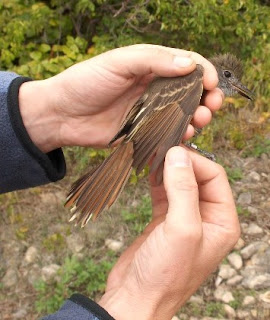Like the capitalist economy, the migration monitoring is subject to boom and bust cycles. However, the only victim is the bander-in-charge, getting desperate for some banding action. It has been a slow week, with very few migrants moving through the area. There’s always a lull sometimes in mid-September, when most of the warblers, flycatchers and vireos have already moved through and kinglets, sparrows, juncos and Yellow-rumped Warbler are still to arrive in numbers…
However, good birding doesn’t need big numbers of birds. For instance, one morning, I saw the end of a hunt by a Merlin over the bay: the Merlin was chasing a small bird over the water, which means no place to hide for the prey. After 3 attempts, the Merlin finally caught its quarry. It is not the first time I’ve witnessed such a hunt. It makes a lot of sense for a Merlin to pursue its preys over water where escape is tough. We have around the area a pair of breeding Merlins and they put on a show from time to time!
Another exciting sighting occurred while I was kayaking on the Bay during a free afternoon: an Osprey flew right over me, as it was coming ashore on the Bruce. It was a rare treat to have this magnificent bird of prey flying low just over me bobbing on the water. Ospreys are shaped almost like gulls and think nothing of crossing large bodies of water like Georgian Bay, which this one undoubtedly did.
To stay with birds of prey (although it could be technically disputed), I saw this morning my first young Turkey Vulture! It was with 4 adult ones, their red head gleaming in the intense sunlight. Not only its grey head was clearly visible, but also its plumage, as a young, was perfectly clean-shaven and fresh. All the adults had a ragged plumage, as moult puts “dents” in their wings and tail. It is the first time in 5 years that a young Turkey Vulture was observed at Cabot Head. Of course, it doesn’t mean no young ever flew by, as we sometimes have a distracted eye towards TVs, or they are too far, but it is nonetheless true that plumage of juvenile birds of prey is so crisp that it could be quite remarkable and detectable at a respectable distance.
Today, an upward trend seemed to begin to materialize; the day started very quietly though, but as a strong south wind began to blow, birds were literally falling from the sky and filling our nets! A lot of Red-breasted Nuthatches, some Yellow-rumped Warblers and a sprinkle of other species of warblers (Black-throated Green, Nashville, and Magnolia). Like an eager stock-market analysis, I keep my senses alert for the rebound!





